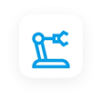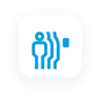Forklifts form an integral part of material management in industrial environments. However, forklifts are also one of the contributing factors that lead to workplace injuries. Estimates show that each year, forklift accidents lead to 34,000 serious injuries, 61,800 non-serious injuries, and around 85 deaths in the US alone.
Being heavy machinery, forklifts require a significant amount of care to control. These forklifts have a weight imbalance. At the rear end, they’re heavy to compensate for the load they need to carry from the front. This also makes turning the forklifts quite tricky. This is why forklifts tipping over is one of the leading causes of fatal accidents.
On the eighth annual National Forklift Safety Day, let's take a look at how evolving technologies like autonomous forklifts can reduce the possibilities of accidents and help keep the workplace safe for everyone.
Common Causes of Forklift Accidents
Before implementing a solution or developing one to improve workplace safety, it is important to understand what causes accidents in the first place.
One of the major causes of accidents that occur while operating forklifts is the driver’s inability to see properly while moving these load-carrying machines. Drivers may face obstruction in their view due to the load that forklifts carry in front of them or when the corridors have tight space for the forklifts to move. One solution to this problem is to install a camera for the driver to see what’s lying ahead. However, this capability can easily become a cause of distraction for the driver.
Another major reason for forklift accidents is overturning, which leads to the machine tipping over. A forklift is most likely to tip over if the driver accelerates hard when turning, leading to an unbalanced load.
Autonomous forklifts are increasingly becoming a viable solution to address these challenges. Let’s discover how these intelligent lifting machines help in preventing accidents and keep the workplace safe.
Sensors are the Heart of Autonomous Forklifts
Autonomous forklifts are fitted with sophisticated sensors that evaluate their surroundings several times per second, and their field of vision is much greater than human perception. Let us take a look at some of the important sensors used in autonomous forklifts.
Laser-Based Distance Trackers: These are safety sensors that emit laser beams to predict the distance between objects. In autonomous forklifts, these sensors help the onboard computer to keep aware of their surroundings. A good laser distance sensor can easily give a 5-meter safety zone with up to 20-meter warning area and with a 270° field-of-view.
IR Obstacle Trackers: An obstacle tracker uses IR (Infrared) LEDs to detect obstacles in front of the autonomous forklift. The IR transmitter emits infrared signals, which bounce back from an object and gets picked up by the IR receiver. Based on the delay in picking up the reflecting signals, the computer can determine the distance between the sensor and the object. Generally, IR obstacle sensors come with a 180° field of view.
2D LiDAR: LiDAR or Light Detection and Ranging sensor use pulsing laser light to map the surrounding. A 2D LiDAR uses a laser sensor to measure two axes. The collected data then gets compiled to create a field of view with all the nearby objects identified and the distance between them.
3D LiDAR: 3D LiDAR adds to the capabilities of 2D LiDAR with additional hardware. This type of sensor uses multiple lasers oriented in different angles to get information on all three axes. The sensors constantly take in data that helps track moving objects in real-time. Instead of multiple lasers, some of the newer 3D LiDAR sensors use a single laser technique and employ a rotating mirror to achieve wider vertical and horizontal field-of-view.
Speed Trackers: These are sensors that allow the onboard computer to track the speed of the forklift. It helps the computer to make necessary adjustments to get the right speed for safe operation.
How Sensors Make Forklifts Safe?
The sensors discussed here serve as the eyes of the forklift. They enable the onboard computer to identify distances and objects around it.
Let’s compare these capabilities with a human operator. The forklift driver will require navigating through the area while focusing on keeping the forklift load balanced. However, human vision is susceptible to shortcomings, the blind spot being a great example. Human vision is also limited to a viewing angle of 180°. Factors like fatigue and distractions that are part of human nature are also likely to come into play if the loading-unloading operations continue for longer durations.
However, modern sensors available today go beyond such limitations. These sensors have over 250° viewing angles. There are also no blind spots as the computer gets real-time information from all directions and processes them in real-time.
In addition to imaging sensors, other sensors like speed sensors, acceleration sensors, and gyro sensors help forklifts avoid overturning. Such advancements and components enable autonomous forklifts to operate 24/7 while maintaining high safety standards.
The Future is Autonomous
The rise of autonomous forklifts is imminent. It is not something you’ll find at the discussion stage but being actively implemented. Recent investments from Amazon and Körber point to this very fact. Sensors are the core components that will allow forklifts to be autonomous and efficient.
At Hokuyo-USA, we provide smart sensing technology solutions that will maximize your business operations and equipment efficiency. Check out our range of smart sensing solutions for autonomous applications here.

 Factory Automation
Factory Automation Logistics Automation
Logistics Automation Process Automation
Process Automation Crane Collision Avoidance
Crane Collision Avoidance LiDAR/Obstacle Detection
LiDAR/Obstacle Detection Safety Laser Scanners
Safety Laser Scanners Optical Data Transmission
Optical Data Transmission Hot Metal Detectors
Hot Metal Detectors Laser Distance Sensor
Laser Distance Sensor Blog
Blog Whitepapers
Whitepapers Case Studies
Case Studies Infographics
Infographics